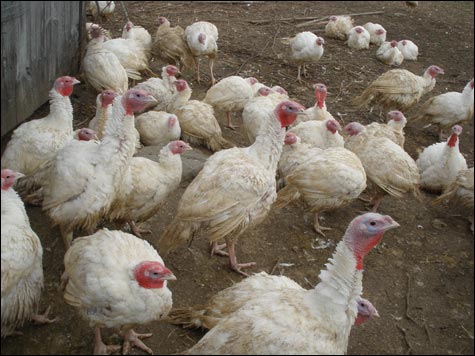
MEET ’EM BEFORE YOU EAT ’EM Maine turkeys get ready for Thanksgiving. |
I've never cooked a turkey for Thanksgiving. Sure, I've helped pack the bird with stuffing and paid my dues basting it throughout the day, but so far I've managed to avoid ultimate responsibility. Frankly, it's too much pressure. But at least I would ruin only my family's Thanksgiving.
John Barnstein figures he's responsible for about 12,000 people's holiday repast. As the owner of Maine-ly Poultry, a small farm in Warren, John raises 2000 turkeys for Thanksgiving. And getting that turkey to your dining room table is nothing short of a battle.
Compared to chickens — which are the core of his business, raising 20,000 a year — turkeys are difficult to manage when they're young because they tend to pile on top of each another if they're too hot or too cold. Once they feather-out, though, they're relatively hardy. But raising any animal outside presents additional dangers.
One year Barnstein lost 75 turkeys in a single night to a coyote and in other years he's battled rats, raccoons, and stray dogs. It's not just predators. A few weeks ago, a huge rainstorm blew the roof off the turkey's shelter, soaking them in several inches of water. Fortunately, the temperature warmed up enough to dry everything out, but it could've been disastrous. "You have to hope you learn a little every year," he says. "It doesn't get easier, but you know how to deal with different crises. It's a constant, never-ending battle to farm."
Then there's the challenge of getting the birds to the right weight to meet his orders. During his 25 years of farming in Warren, Barnstein's experimented with different breeds, raising both black and bronze turkeys, but says broad-breasted white turkeys have more breast meat, which is what most folks want for Thanksgiving. And they want them to be between 12 and 16 pounds, but it's not unusual to raise birds in the 30-pound range. "When we get the order we try to come as close to the weight as possible, but people have to be willing to accept the difference because the growing season is always different," he says.
Expect to see bigger birds because this was a great year, with mostly dry and warm conditions, so birds will likely be on the heavier side. But, for the most part, customers understand. "People know they're getting fresh, farm-raised turkeys that have been raised locally, with no antibiotics, that run around outside, so they're willing to have some leeway on the exact weight," he says.
And then comes the week before Thanksgiving, when the pressure really sets in. Because John wants to sell the freshest possible bird, he waits until just days before Thanksgiving to start slaughtering. Between Barnstein and his five farmhands, they manage to process 300 birds a day, but have done as many as 500 when things haven't gone as planned. He gets up around 3:30 am to get the equipment going and doesn't finish until after dark. "I don't sleep much for a week," he confesses.
While he could slaughter the birds earlier and add a 3-percent salt solution or chlorine to increase shelf life, Barnstein says that would defeat everything that's gone into the turkeys so far. "We go to the trouble of raising a good bird with no antibiotics, so why chlorinate it?" he asks.